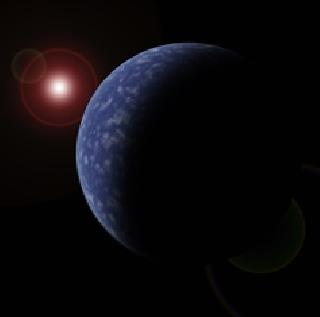
Artist's impression of one of the newly discovered planets, in orbit around a red dwarf star at top left. Image credit: Neil Cook, University of Hertfordshire.
LONDON (BNS): A team of astronomers from UK and Chile has discovered eight new small exoplanets orbiting nearby red dwarf stars, three of which could be in the "habitable zone" to support life.
Using data from the Ultraviolet and Visual Echelle Spectrograph (UVES) and High Accuracy Radial velocity Planet Searcher (HARPS) instruments operated by the European Southern Observatory in Chile, the researchers estimate that a large fraction of red dwarfs, which make up at least three quarters of the stars in the Universe, has associated low-mass planets.
The new-found planets orbit their red dwarf stars between 15 and 80 light years from the Sun, making them relatively close to the Solar System.
The eight planets take between two weeks and nine years to complete one orbit, placing them at a distance from their stars of between 6 and 600 million km (equivalent to between 0.04 and 4 times the distance from the Earth to the Sun).
Those falling in the so-called habitable zone of their stars are only a little more massive than the Earth. Planets in this region, where the temperature is just right for water to be present as a liquid, are more likely to be able to support life.
"We were looking at the data from UVES alone, and noticed some variability that could not be explained by random noise. By combining those observations with data from HARPS, we managed to spot this spectacular haul of planet candidates," said lead researcher, Mikko Tuomi, of the University of Hertfordshire.
"We are clearly probing a highly abundant population of low-mass planets, and can readily expect to find many more in the near future -- even around the very closest stars to the Sun."
The new discovery adds eight new exoplanets to the previous total of 17 already known around such low-mass red dwarf stars.
The team also plan to follow up a further ten weaker signals, the Royal Astronomical Society said.
The new work appears in the journal Monthly Notices of the Royal Astronomical Society.
 Previous Article
Previous Article Next Article
Next Article













The Indian Air Force, in its flight trials evaluation report submitted before the Defence Ministry l..
view articleAn insight into the Medium Multi-Role Combat Aircraft competition...
view articleSky enthusiasts can now spot the International Space Station (ISS) commanded by Indian-American astr..
view article